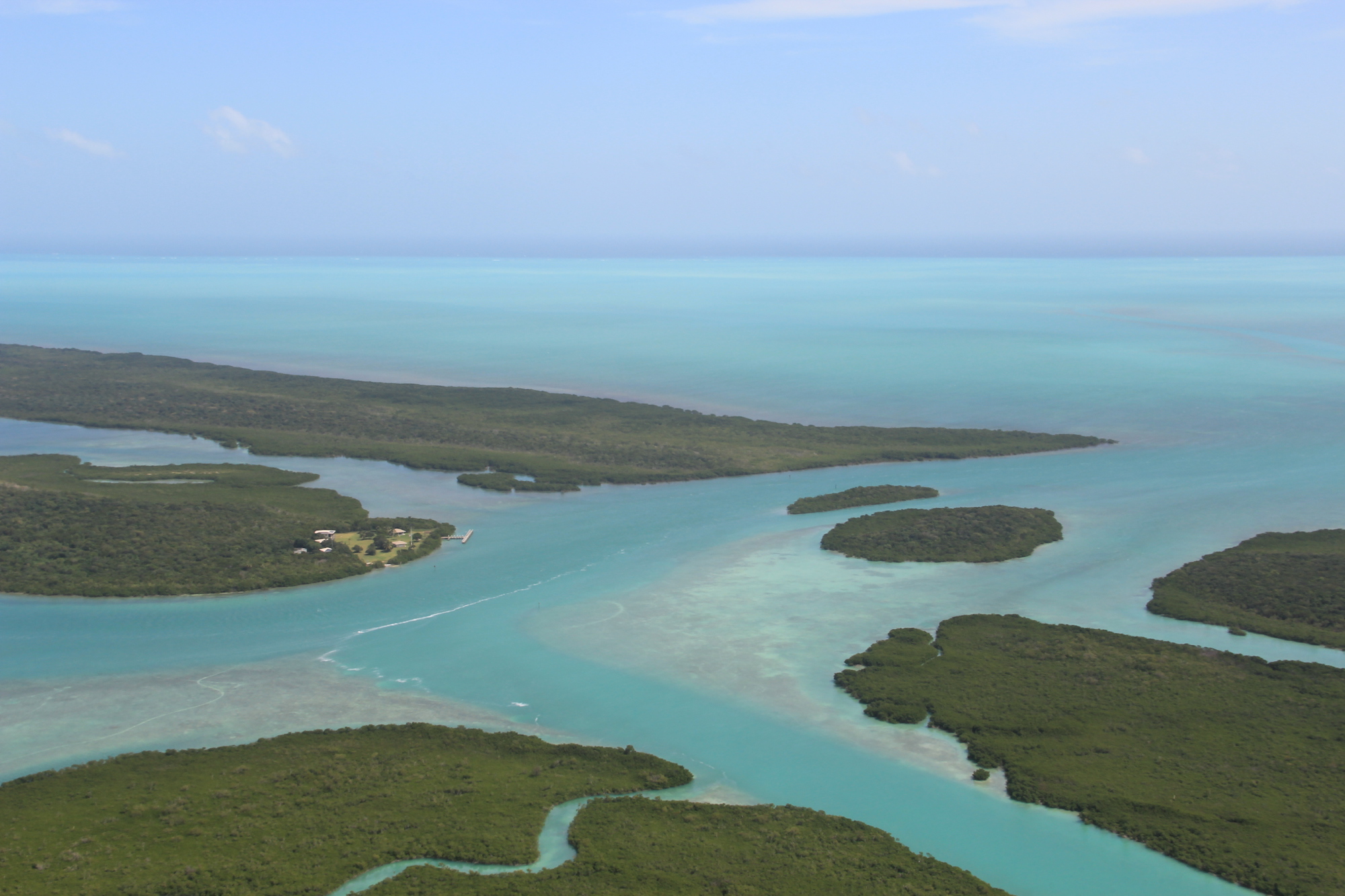
It’s a cloudless day in Biscayne National Park in South Florida, and the calm of the bay is suddenly broken by boisterous teenagers plunging into the warm, crystal-clear waters. The kids are preparing for their first dive of the day at the park. They’re members of Youth Diving With a Purpose, predominantly black descendants of slaves who are helping the National Park Service survey historic shipwrecks. The program began in 2003, when a group of black scuba divers teamed up with the NPS in an effort to find the Guerrero, a sunken slave ship that is said to have crashed along Carysfort Reef in 1827. Participants in the program are given the chance to learn about and document a time in history that’s linked to their identity as descendants of enslaved people. “We are a small part of a bigger solution to getting a more complete understanding of slavery,” says Tristan, an 18-year-old member of Youth Diving With a Purpose.
Once a thoroughfare for slave ships en route to the Americas, Biscayne National Park owes its existence, in large part, to the family of Israel Lafayette Jones, a black pioneer who, at the height of Jim Crow, built an agricultural empire and quietly became the largest land owner in Miami-Dade County. The Jones family was the park’s largest benefactor.
Nestled between Miami and Key Largo, Biscayne National Park is 95 percent water. It is home to one of the world’s largest coral reefs and artifacts that are at least 10,000 years old.

What is little known about Biscayne’s past is its rich black history, beginning with the mythical pirate Black Caesar. Legend has it that Caesar was a prominent West African chieftain before being tricked into boarding a slave ship bound for Florida. He and 20 of his warriors were lured onto the ship by the captain, who distracted them with jewelry, food and the promise of more treasures on the ship. As Caesar and his men feasted, the captain quietly ordered his men to raise anchor and sail away. The West Africans’ attempt to fight back was quickly quashed by pistols and swords.
What is little known about Biscayne’s past is its rich black history, beginning with the mythical pirate Black Caesar.
As Caesar awaited his fate below deck, a sailor is said to have befriended him. When the ship was hit by a hurricane near the Florida coast, the sailor freed Caesar, and the two escaped on a rowboat with ammunition and supplies before they crashed against a reef. The men then adapted to a life of piracy, luring boats near a shallow, patchy, maze of mangroves, now known as Caesar Creek, by pretending to be shipwrecked sailors. Once aboard a ship, they would draw their weapons, loot the vessel and bury their fortunes on nearby Elliott Key. “It’s more fiction than fact,” says Joshua Marano, a maritime archeologist with the National Park Service, “but the symbolism is applicable to this entire region.”
The tale of Black Caesar lives on as a symbol of this wild frontier where black Americans had the opportunity to shed the chokehold of slavery.
“A lot of people,” says Morano, “when they think of the American frontier, they think of the West and the Great Plains, but down here, even up until the 1890s, this place was undeveloped.” In the 1820s, enslaved Africans and black Seminoles used the remote, southernmost tip of Biscayne Key as a path to freedom. Blacks in Alabama, the Carolinas, Georgia and central Florida fled to the tip of Florida’s peninsula, crossed the bay to Key Biscayne and trekked to the islands’ southernmost tip, Cape Florida. Here, they bartered with Bahamian captains along the beach, negotiating safe passage across the Gulf Stream to Andros Island, among other places, says Joan Gill Blank, author of Key Biscayne: A History of Miami’s Tropical Island and the Cape Florida Lighthouse. Blank first learned that Key Biscayne was part of the Underground Railroad while sailing in the Bahamas in 1962. She dropped anchor in Nicholls Town on Andros Island. A couple locals asked her where she was from. When she said Cape Florida, they replied, “Same.” An estimated 300 people had escaped to the Bahamas from Key Biscayne.

After nine years cultivating crops and clearing land for others, Jones decided he wanted something of his own. In 1897, he bought Porgy Key for $300 from a white Bahamian named Fletcher Albury. The 63-acre island is in the heart of Caesar Creek.
In the late 1800s, during the Reconstruction era, Jim Crow laws prevented blacks nationwide from participating in political processes, acquiring land, seeking employment or using public accommodations. In Florida, racial discrimination and violence were especially pervasive. From 1900 to 1930, Florida had more lynchings per capita than any other Southern state. At the voting booth, whites-only elections and poll taxes remained in place for decades. Black Floridians lived with a constant fear of violence with the rise of the Ku Klux Klan and attacks on family homes.
It was in this climate that Jones bought his first piece of property for less than five dollars an acre, becoming the first black landowner in the Keys. “No one had ever lived on the keys except the lighthouse-keepers, and it was a savage place, alive with rattlesnakes,” Jones’ friend, Vincent Gilpin, said in an interview with the National Park Service. “He killed hundreds, one of them ten feet long—a real granddaddy. Other pests such as wildcats soon scattered, and the property grew into the semblance of a gentleman’s home.”
After harvesting his neighbor’s farmland for nine years, Jones could see production and sustainable homesteading potential where others saw uninhabited jungle. His work ethic and strategic approach to self-sufficiency are apparent early on, beginning with the land-clearing process. He cleared land next to the water, first to build a fishing dock and make the ocean his primary source of sustenance. Lobster, crawfish, snapper and conch lived among the mangroves, making food easy to come by. “The sea was an inexhaustible storehouse of delicacies,” said Gilpin. “There was no question of ‘making’ a living; all one had to do was pick it up.”
On land, Jones’ agricultural skills propelled his family beyond homesteading and into a profitable business. His specialties of pineapples and key limes were known to locals as “pines and sours.” Jones’ talents were documented by horticulturist John Gifford, who credited the land owner with creating the most successful lime cultivating technique in the region.
Living on an island shielded the Jones family from some of the oppressive violence, economic disenfranchisement and racial overtures endured by blacks on the mainland
Jones ignored traditional planting methods, catering solely to the root systems. He planted limes closely together, mimicking their behavior in the wild to stimulate growth. The tight placement encouraged the plants to compete for space and grow abundantly. Jones began to see a profit from his crops within two years and benefited from longer-lasting sustainability by planting more limes than pineapples. Pineapples are more susceptible to the elements and are easily ruined during a storm or hurricane.
In 1906, Jones’ strategy of prioritizing limes was tested when a hurricane hit the region. Jones’ lime trees remained mostly intact, but much of the pineapple-only land was decimated. This presented another opportunity for Jones to take more property off the hands of farmers eager to get rid of seemingly unusable land.
In 1911, Jones purchased Totten Key from a former employer for $212, at $1 an acre. Budge decided to sell after the hurricane destroyed his entire pineapple crop for the year. Budge maintained that the land was worthless, but Jones started planting limes immediately, putting 50 acres into cultivation.
With the help of his sons, Jones installed a mini-railroad the length of Totten Island, hauling limes from the groves to the packing house in the summer, and tomatoes in the winter. They also dug a 300-foot-long trench to allow merchant boats to access the island for weekly shipments. In little time, Jones’ family farm became one of the largest producers of pineapples and limes on the East Coast of Florida. The farm brought in an annual income between $30,000 and $40,000, and he benefited handsomely when he sold the plantation property on Fort Totten for $250,000, 14 years after buying it for a mere $212. Living on an island shielded the Jones family from some of the oppressive violence, economic disenfranchisement and racial overtures endured by blacks on the mainland, but they were not exempt. Lancelot and Arthur were not allowed to attend the school on Elliot Key because of their race. Instead, they were tutored and eventually forced to commute to Jacksonville for an education. Israel Jones devoted himself to developing black institutions in Florida, preaching at Mt. Zion Baptist Church in Miami and helping create the Florida Baptists Academy, and a Negro industrial school in Jacksonville, where Arthur and Lancelot attended classes.
Israel died in 1932, and his wife followed shortly thereafter, leaving their remaining islands to their sons. Arthur and Lancelot continued the lime business after their father’s passing, increasing production to 65 acres to become the largest individual key lime growers in the state. After seven profitable years, a series of hurricanes stalled production. Thwarted by lackluster harvests over the next few years, the brothers decided to forego the lime-growing business in 1938. Lifelong stewards of the land, Arthur and Lancelot started a side business of guide fishing in 1935. They began taking members of the millionaire social club Cocobolo Cay on fishing trips along the coast. The club’s tenure ran parallel to Miami’s development boom. Carl Fisher, who developed the pristine white sand Miami Beach we know today, founded Cocolobo Cay Club in 1921. The club struggled after the stock market crash and briefly foreclosed in 1934. Lancelot seized the opportunity to join as a fishing guide. The club, and Miami, bounced back in the mid-1930s, when millionaires flocked to the peninsula every winter.

Arthur and Lancelot became full-time guides, living comfortably off of fishing expeditions with Presidents Hoover, Nixon, Johnson and Kennedy, US senators and millionaires. But as Miami changed, so did its neighbors. In 1961, a majority of Biscayne Bay’s landowners voted to turn the bay into a city called Islandia, making it the smallest municipality in Dade County. Islandia consisted of 32 islands, including the three belonging to Arthur and Lancelot: Porgy, Old Rhodes and Totten Keys. They were the second-largest property owners in Islandia. “Originally, there were 12 people in this area, but by 1935, that had dropped down to six people, and by the 1940s, everyone had left except me. I am the last one,” Lancelot said in an interview. In 1966, his brother Arthur died.
Lancelot was the first to sell his property to the federal government for the creation of the park.
Lancelot was not opposed to development at the time of Islandia’s incorporation. Islandia, however, was different. Once it was incorporated, development-minded land owners unveiled plans for a major industrial seaport, including an oil refinery and petrochemical plants on the bay, south of Miami. This would mean dredging a 15 mile channel through the shallows of the bay to allow tankers and other large-hulled ships to reach the Atlantic. Lancelot opposed the proposition and refused to sell his property to billionaire shipping mogul Daniel K. Ludwig, who was believed to be behind the scheme.
Shortly after news broke of Islandia’s plan for Biscayne, a small group of protestors created the Safe Progress Association. The group’s vision was for the bay to become a water-based national park, protecting Miami’s rich aquatic wildlife and historic artifacts. The group gained traction after a series of articles in the Miami Herald detailed the plan. Soon, local politicians weighed in, calling for the park’s preservation.
In 1968, Lancelot’s old fishing buddy, President Johnson, signed the Biscayne National Monument Bill. Lancelot was the first to sell his property to the federal government for the creation of the park under the condition that he be permitted to live out the remainder of his life in his family home on Porgy Key. The park service agreed and purchased the 277 acres that make up Totten, Old Rhodes and Porgy Keys for $1.27 million. Others estimate the land likely would have sold to developers for over $3.5 million.
Lancelot spent almost all his remaining years on Porgy Island. According to the National Park Service (his only neighbors), he used rainwater for washing, solar panels for 12-volt electricity, and a sawdust hole housing a block of ice as a refrigerator. On occasion, Lancelot visited the Park Rangers at Adams Key, on the site of the former Cocolobo Club. He also volunteered with the Park Service’s environmental education program, talking to schoolchildren about the park’s wildlife.
Lancelot Garfield Jones died in 1997, at age 99. Seven years after his passing, Cape Florida was designated a National Underground Railroad Network to Freedom Site.




